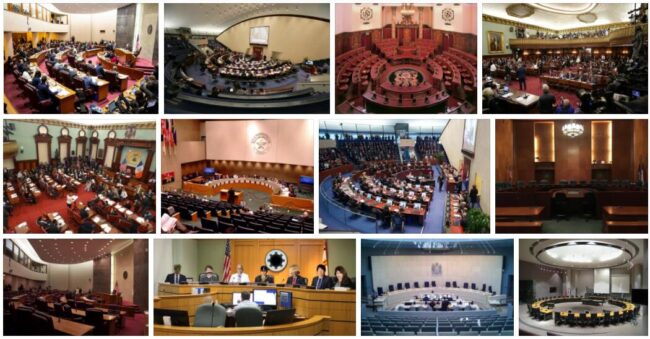Nebraska is one of the 50 states of the United States of North America. The state is located in the Midwestern region of the US and has 1,842,641 inhabitants (2011). The capital is Lincoln and the standard abbreviation for the state is NE.
Nebraska borders South Dakota to the north, Iowa and Missouri to the east, Colorado and Kansas to the south, and Wyoming to the west.
The state consists for the most part of an undulating plain that is prairie-like in nature. The plain gradually slopes west into the foothills of the Rocky Mountains.
The Rocky Mountains is a collective term for the large mountain area that extends in western North America from the extreme north to the south, where it continues into the Andes Mountains of South America.
Lakes and Rivers
The main rivers in Nebraska are the Platte River and the Missouri, into which the Platte flows. The Platte forms the entire eastern border of the state.
The North Platte River and South Platte River meet at North Platte.
Nebraska has more than 2,300 lakes and lakes, including a number of man-made lakes.
Lake CW McConaughy, through which the North Platte flows, is the largest lake in Nebraska.
Climate and holidays
Nebraska has a continental climate, but the winters are not very cold on average, thanks to the chinook, a warm wind that comes from the Rocky Mountains.
Storms, blizzards, and tornadoes are common in the state.
Major tourist attractions in Nebraska include Wildcat Ridge, the hills along the Missouri River known as Bluffs, the Niobrara Valley, and the Sand Hills Lake District.
Herds of bison live in the Niobrara Nature Reserve.
A historic site of interest is the Platte Valley, home to important pioneer routes such as the Oregon Trail, the Pony Express, and the Overland Trail.
Buffalo Bill’s home is near North Platte.
The city of Lincoln was founded in 1856 as Lancaster. At the time, Omaha was the capital of the Nebraska Territory, but the people wanted a more central capital and Lancaster was chosen.
On March 1, 1867, Nebraska officially became a US state and Lancaster’s name was changed to Lincoln, after the assassinated US President Abraham Lincoln.
Cities Nebraska
Besides the capital Lincoln and the largest city Omaha are a number of other cities in Iowa: Bellevue, Grand Island, Kearney, Fremont, Hastings, North Platte.
Norfolk, Papillion, Columbus, La Vista, Scottsbluff, South Sioux City, Beatrice, Lexington, Gering, Alliance Blair, York. McCook, Nebraska City.
Nebraska counties
The American state of Nebraska is administratively subdivided into 93 counties.
Nebraska
The American state of Nebraska borders the states of South Dakota, Iowa, Missouri, Colorado, Kansas and Wyoming. The capital is Lincoln.
Niobara National Scenic River
The Niobara River is considered a National Natural Monument of Nebraska and runs about 300 miles (480 km) through its northern section, northwest of Omaha. In 1991, the US Congress abolished protection over approximately 120 km of the Niobara River. However, there are still many natural attractions of exceptional value under protection. There is a beautiful landscape, rich flora and fauna, fossil resources, high water quality and varied recreational opportunities. The river was named one of the top 10 rivers for canoeing in the United States by Backpacker magazine.
There are many attractions along the river, such as numerous cliffs, canyons, rock walls and waterfalls, the highest of which is Smith Falls, which drops 19 meters into the river valley. Smith Falls is even the tallest waterfall in Nebraska. There are short stretches of rapids on the river that paddlers like to seek out. Great opportunities for canoeing, kayaking, fishing and other water sports are offered in the westernmost section of the river around Fort Niobara, east of Valentine.
Although there are excellent rowing opportunities in the remaining parts of the river basin, public access is limited as these lands belong to private landowners. You need a permit to enter these places. Around 70,000 people visit the recreational area of the Niobara River every year, the busiest period being from June to August. In late summer, the water level may drop slightly.
Niobara is home to more than 500 species of plants, even several species that are normally found quite far away, even several hundreds of kilometers, have been found here. These species include birch, juniper and heavy pine. Birches, lindens, aspens, ferns and mosses grow on the cooler northern slopes. Towards the east, rather deciduous forests grow, consisting of elms, poplars, green ash, oak, elm and others. There are three types of prairies in the river valley, which are botanically very diverse. To the east is tallgrass prairie, mixed prairie is found around the Sandhills, and to the west is shortgrass prairie.
The Niobary area has also become home to many animals such as deer, beaver, mink, antelope, coyote and you can even come across bison. Today, approximately 400 of them live here. A few dozen protected moose also roam the 77 km2 area. The waters of the Niobara are home to larger fish such as rainbow trout, which prefer cooler, cleaner water. Catfish also live here, but they stay in deeper waters.




